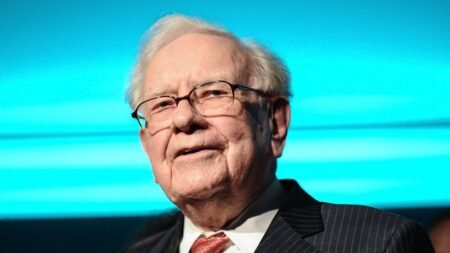SOPA Images / Contributor / Getty Images
These days you don’t have to pay a penny in commissions to trade stocks or ETFs or fork over a dime to access investment research and portfolio management tools. It’s the perks that’ll cost you extra.
Webull is the latest deep-discount trading app putting the good stuff behind a paywall. For $3.99 a month (or $40 annually), Webull Premium subscribers get better rates on uninvested cash, margin loans, derivatives commissions and market data, and a higher IRA match on contributions and transfers.
Here’s how the new Webull Premium service compares to its free offering:
| Webull Premium | Webull Standard | |
|---|---|---|
| APY on uninvested cash* | 4.1% | 0.5% if account balance is less than $25,000; 2.86% if account balance is $25,000 or higher |
| IRA match rate | 3.5% on new contributions; 3% on up to $500K in IRA transfers through 6/30/25 |
1.0% on new contributions; No IRA transfer match |
| Margin loan rates (rates are variable) | 4.65%-5.95% based on loan size | 8.74% on all amounts |
| Index (non-equity) contracts | $0.10 discount based on monthly trading volume: $0.50 per contract on first 1,000 contracts/month and then $0.30-$0.40 per contract |
$0.50 per contract |
| Futures contracts | $0.15-$0.75 based on monthly trading volume and specific futures contract (Note: Premium discount does not apply to first 5,000 contracts per month) |
$0.25-$1 based on monthly volume and specific futures contract |
| Data | Free real-time data (includes Level 2 Nasdaq TotalView and OPRA) | $2.99 monthly subscription required for Level 2 and other real-time data |
Does any of this look familiar? It should
Robinhood — one of Webull’s closest competitors — offers similar enhanced rates through its Robinhood Gold subscription program.
The model is clearly working for the broker: In 2024, Robinhood Gold had 2.6 million subscribers, which represented an 86 percent year-over-year increase in membership.
The timing couldn’t be better for brokers like Webull to explore additional revenue streams, particularly when their main source of income (transaction fees) is impacted when nervous investors pump the brakes.
Of course, in a market where rock-bottom fees and free trading is the norm, you’ve got to make a compelling case to get customers to open their wallets. Let’s look at how Webull Premium compares to the competition.
Webull Premium vs. Robinhood Gold
Both Robinhood Gold and Webull Premium offer perks designed to appeal to high-volume traders, including per-contract discounts on index options and futures and lower rates on margin loans. Each also has a hook for everyday savers — a boosted IRA match rate that’s only available to paying customers.
Here’s how Webull Premium stacks up against Robinhood Gold on investor-focused services:
| Webull Premium | Robinhood Gold | |
|---|---|---|
| Subscription cost | $3.99 per month or $40 per year | $5 per month or $50 per year |
| APY on uninvested cash | 4.1% | 4.0% |
| IRA match rate | 3.5% on new IRA contributions; 3.0% on IRA transfers up to $500K made by 6/30/2025 |
3.0% on new IRA contributions; 1.0% unlimited match on IRA transfers |
| Margin loan rates (variable) | 4.65%-5.95% based on loan size | 0% on first $1,000 borrowed and then 4.7%-5.75% based on loan size |
| Index options contracts | Index options: $0.30-$0.40/contract after first 1,000 contracts/month | Index options: $0.35/contract (vs. $0.50 without Gold) |
| Futures contracts | Futures: $0.15-$0.75 based on monthly volume and specific futures contract (Note: Premium discount does not apply to first 5,000 contracts per month) |
Futures: $0.50/contract (vs. $0.75 without Gold) |
| Access to free enhanced data | Free Nasdaq Level 2 data, OPRA market data | Access to Nasdaq Level 2 data and Morningstar analyst reports |
Which is the better deal? It depends on how — and how much — you invest. And also what other financial services you’re interested in using.
Trading fees
Winner: Webull Premium has an edge for high-volume traders
Webull Premium’s per-contract discounts are on a sliding scale. However, the savings don’t kick in until monthly contract minimums are met. Lower-volume traders may be better off with Robinhood’s flat per-contract pricing model with no minimum trade restrictions.
Margin rates
Winner: Robinhood’s low margin rates don’t require a Gold subscription
Both Gold and non-Gold customers are eligible for Robinhood’s already-low margin rates (currently 4.70-5.75 percent). The only difference is that Gold members pay zero percent interest on the first $1,000 borrowed.
Webull Premium members qualify for a margin rate discount, paying 4.65-5.95 percent (based on the margin loan amount) versus the non-subscriber 8.74 percent rate (regardless of loan amount). (Here’s how margin rates at other brokers stack up.)
Other perks
Winner: Robinhood Gold subscribers get more benefits overall
Part of Robinhood Gold’s success is that it continuously bundles in new member benefits that make the subscription appealing to a wider range of consumers, not just active traders. Members have access to the company’s rewards credit card, access to higher “instant deposits” for pending brokerage contributions, a break on fees for the company’s newly launched portfolio management service, Robinhood Strategies, and more.
Bottom line
Premium membership plans aside, if you’re looking for a low-cost, low-frills trading platform, Robinhood and Webull are neck-in-neck in the categories we use to rate brokers, including where they are lacking (no mutual funds, limited customer service and IRA types).
Those willing to pay for enhanced services will get access to a wider range of benefits with Robinhood Gold. That said, Webull Premium is brand new, and the company says it plans to add more features and benefits over time. With the brokers’ service overlap — both offer automated portfolios (Webull’s is called Smart Advisor), cash management accounts and events trading — Webull Premium and Robinhood Gold could end up looking a lot alike.
Editorial Disclaimer: All investors are advised to conduct their own independent research into investment strategies before making an investment decision. In addition, investors are advised that past investment product performance is no guarantee of future price appreciation.
Read the full article here

















